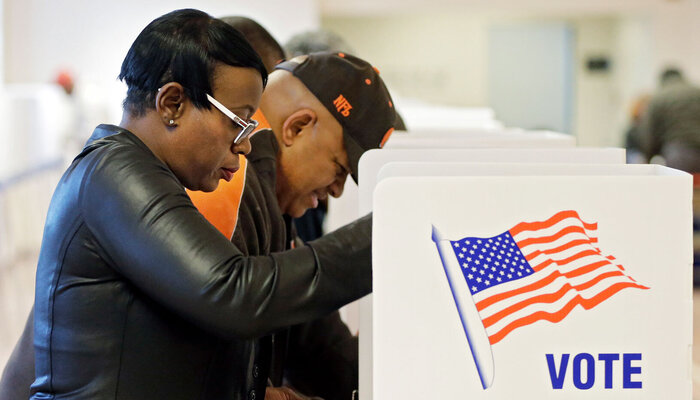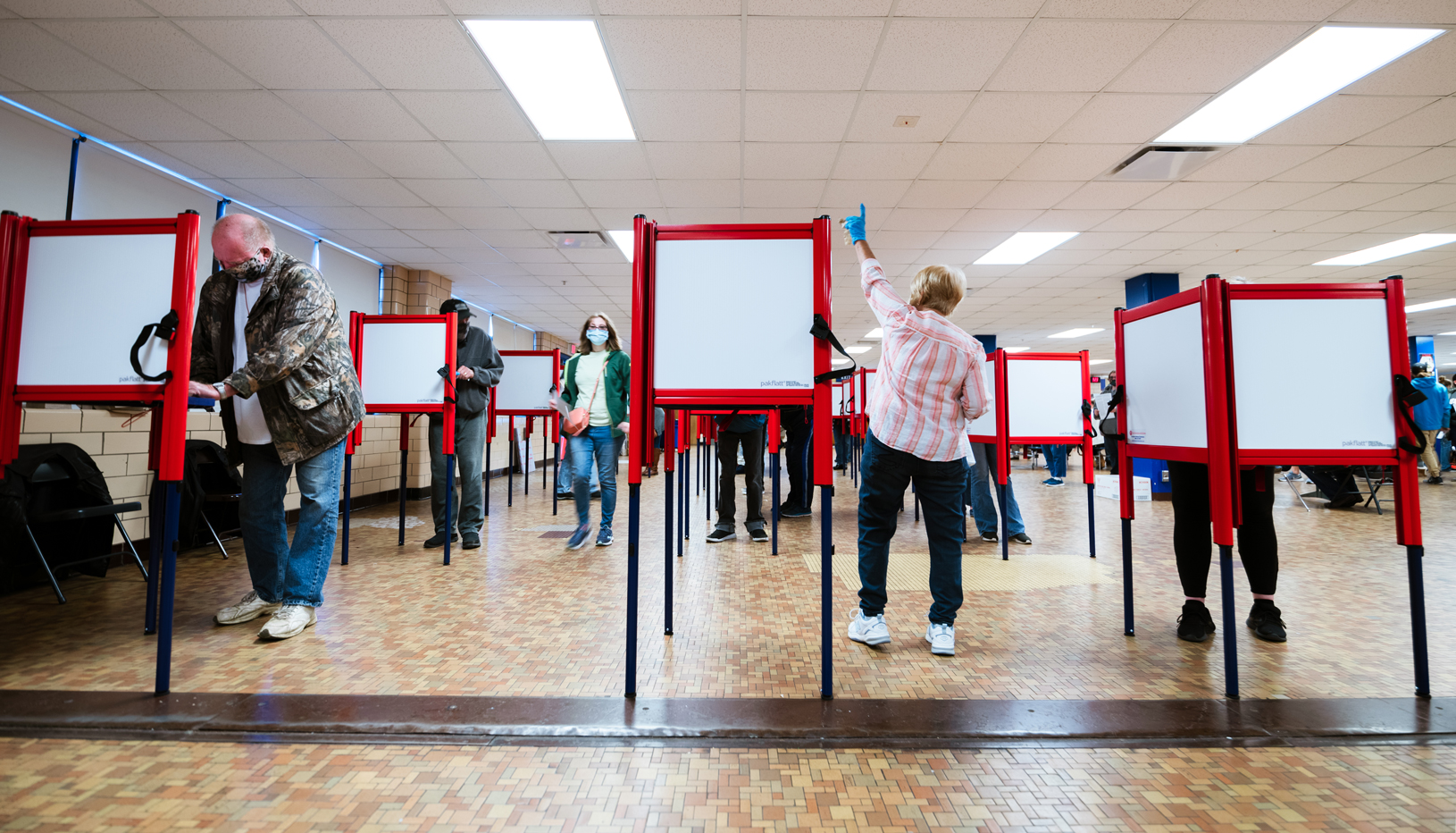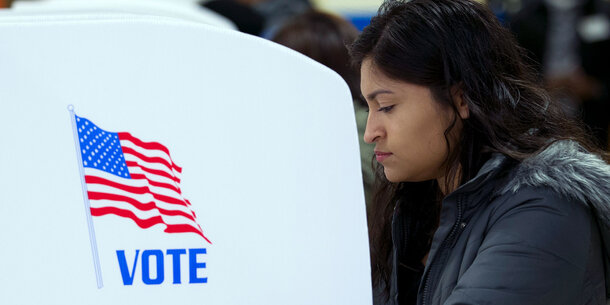American democracy recently dodged a number of threats — but the freedom to vote is still at risk.
Last fall, voters in key battleground states rejected candidates for governor and secretary of state who ran on election denial platforms. This past term the Supreme Court preserved a key provision of the Voting Rights Act and maintained important checks on legislative power to administer elections. Americans continue to embrace pro-voter policies like expanded early voting and mail voting when they are at stake at the ballot box.
At the same time, election denial — the effort to discredit election results based on false allegations of widespread fraud — is still a potent force in our politics. It has spilled over into outright harassment and even violence targeting election officials and voters. States continue to pass laws to roll back voting access and make partisan meddling in election administration easier. Extreme gerrymandering, dark money in elections, and other longstanding problems are at historically high levels. The Supreme Court continues to be very hostile to voting rights relative to even a decade ago, and some state courts that had been more protective are retreating. Even initiative processes that voters have used to expand voting rights are threatened.
Strong congressional action is critical to protect the freedom to vote and safeguard elections. The best solution remains for Congress to set baseline national standards for voting and elections like those in the Freedom to Vote Act. This legislation, coupled with the equally important John R. Lewis Voting Rights Advancement Act, must remain at the top of the national agenda.
Historic Threats to American Democracy Persist
Election denial is a widespread and potent force in our politics. As outlined in our research detailing 14 tactics deployed by election deniers throughout the 2022 election cycle, false assertions of widespread voter fraud and related conspiracy theories continue to threaten the integrity of our elections.
In 2022, voters in battleground states rejected candidates who ran on election denial platforms in key statewide races. But officials who have expressed sympathy for election denial won important statewide offices elsewhere. And even where candidates who ran on election denial lost statewide, other candidates won critical local roles that directly oversee voting and the tabulation of results.
Having officials sympathetic to election denial on the inside has the potential to compromise the safety of our elections in a range of ways. For example, election deniers who infiltrated election offices have given unauthorized access to voting equipment and even allowed people to copy the hard drives of voting machines and post them online.
Attacks on election officials and related political violence are on the rise. The January 6 attack on the Capitol attempting to overturn the 2020 election was shocking, but it was not the only instance of political violence fueled by election denial.
Election denial campaigns have also prompted an ongoing wave of threats and harassment against election officials and poll workers. In a recent poll of local officials commissioned by the Brennan Center, almost one in three reported having suffered abuse, harassment, or threats. Nearly half expressed concern for the safety of their colleagues.
This climate also impacts voters: some Americans are beginning to feel uncomfortable at polling places and other voting locations. These concerns are understandable in light of incidents such as armed citizens at drop boxes, reports of Black voters being harassed, polling place disruptions, and networks of people going door to door to scare registered voters away from the polls. State proposals to allow guns in polling places have the potential to make matters worse.
Partisan interference with election administration is also on the rise. The Brennan Center’s Voting Laws Roundup determined that in 2022, at least seven states enacted 12 laws to make it easier for partisans to meddle with election administration or threaten election officials. As of May 29 of this year, at least four states have passed five such election interference laws. Our recent election official poll found that 56 percent — including large numbers of self-described Democrats, Republicans, and Independents — worry about partisan meddling in their colleagues’ work.
Officials sympathetic to election denial, egged on by unscrupulous candidates, have also become increasingly bold in trying to delay certification of lawful election results. Other emerging tactics to thwart or discredit election results include sham partisan reviews of election results seeking without basis to uncover evidence of supposed fraud, as well as demands for all ballots to be hand-counted based on conspiracy theories about the accuracy of voting machines.
Election disinformation has affected even the most noncontroversial electoral safeguards. For instance, conspiracy theories have recently led several states to pull out of the Electronic Registration Interstate Compact, a consortium through which states share voter information to keep their rolls up to date that previously had strong bipartisan support.
States are restricting the freedom to vote with growing frequency. The election denial movement has intersected with an ongoing barrage of new voting restrictions. Since the Supreme Court hobbled the Voting Rights Act’s protections against racial discrimination in 2013, 29 states have added 94 new restrictions on the freedom to vote.
The push for new restrictions gained intensity following the attempt to overturn the 2020 election. Based on our latest Voting Laws Roundup, at least 11 states enacted 13 restrictive laws through May 29 of this year. This came on the heels of widespread state legislative activity curtailing voting rights in previous years. In 2021, at least 17 states enacted 32 restrictive laws, while at least 8 states passed 11 new restrictions in 2022. The sponsors of these laws were often the same legislators who questioned the 2020 result. Many new restrictions reflected the same baseless allegations that appeared in post-2020 lawsuits.
New voting restrictions disproportionately harm voters of color. Indeed, while turnout overall in recent cycles has been high, the push to restrict voting has coincided with a sharp increase in the racial turnout gap. Nationally, one study found that Black turnout fell almost 10 percent between the 2018 and 2022 midterms, while white turnout dropped only 1.5 percent, leading to the highest turnout gap in any national election since at least 2000. In Georgia, the white-Black turnout gap expanded almost 50 percent in four years. In Alabama, the white-Black turnout gap tripled from three percent in 2012 to nine percent in 2022, and the gap between white voters and all voters of color grew from seven to 13 percent during the same interval.
Gerrymandering remains at historically high levels. Gerrymandering continues to distort congressional elections, potentially impacting control of the House. For instance, a new Republican-drawn map for Florida created only eight Democratic-leaning districts out of 28 (four fewer than under the previous map), despite Democrats having won almost half the statewide popular vote in closely contested elections in 2020 and 2018.
The Supreme Court’s unexpected June decision upholding protections against racial gerrymandering may mitigate egregiously biased maps in several states. But the 2022 elections were held under the extreme and (under the terms of the Supreme Court’s recent ruling) potentially unlawful maps in Alabama, Louisiana, and elsewhere; those maps are illustrative of the kinds of abuses becoming more common. Other decisions will likely make gerrymandering worse. Recently in North Carolina, for example, a new state supreme court majority abandoned its prior rulings limiting partisan gerrymandering and cleared the way for a GOP legislative supermajority to draw new biased maps.
Our campaign finance system is still broken. The last two election cycles were the most expensive on record, with more money than ever coming from a tiny, highly unrepresentative slice of the wealthiest Americans. The 100 top federal donors of 2022 — a number of whom also back the election denial movement and other extreme causes — collectively spent roughly $1.2 billion. That was 60 percent more than what came from the roughly 3.7 million Americans who gave small contributions of $200 or less. Campaign money is also harder to trace, as dark money increasingly goes through conduits or is spent online, where disclosure requirements are limited.
Existing guardrails are not enough. Current legal guardrails are not enough to protect the freedom to vote and safeguard elections. The last Supreme Court term’s positive rulings on gerrymandering and rejecting the extreme “independent state legislature theory” were welcome — but they will not erase the damage of previous decisions that hobbled the Voting Rights Act, curtailed other voting protections, left gerrymandering unchecked, and eviscerated campaign finance limits. Some state courts have stepped in to protect the freedom to vote, but their power is sometimes limited, and others are moving in the wrong direction.
Ballot initiatives to expand voting rights, curb gerrymandering, and limit campaign money, which have succeeded in some areas even in the face of hostile legislatures and courts, are not available in every state. And some state legislatures and courts are seeking to make it harder for initiatives to get on the ballot and pass.
The Freedom to Vote Act Meets These Challenges
The Freedom to Vote Act shores up the freedom to vote and strengthens American democracy. It sets baseline national standards to protect voting access and make it harder for partisans to manipulate elections. It creates new protections for election officials and workers, prohibits partisan gerrymandering, and blunts the problem of dark money. These and other key provisions all draw from best practices in the states. Legislation combining the Freedom to Vote Act with the equally necessary John R. Lewis Voting Rights Advancement Act — which would restore and update the Voting Rights Act’s protections against racial discrimination in voting — came extremely close to passing in 2022. Along with consistent federal funding to help states run elections, these bills are needed now more than ever.
Protecting the Freedom to Vote Is the Right Thing to Do — and It’s Popular
The Freedom to Vote Act is popular. Seventy percent in one poll — including 54 percent of Republicans — supported its passage, while 63 percent of likely voters (including 42 percent of Republicans) supported passage of the combined Freedom to Vote Act and John R. Lewis Voting Rights Advancement Act in another poll. Voter support is even stronger on specific policies such as expanding early voting, ending gerrymandering, protecting election workers, and curbing dark money.
These policies continue to have momentum in the states. Voters have repeatedly passed them, often by lopsided majorities, through ballot initiatives. State legislative majorities that campaigned on strengthening democracy are also moving to enact them.
Passing landmark federal legislation is always a long process; the 1965 Voting Rights Act was the product of over a decade of advocacy and passed only on the heels of weaker laws. The Freedom to Vote Act demands similar perseverance. It is not just the right thing to do, but also what the American people want.








